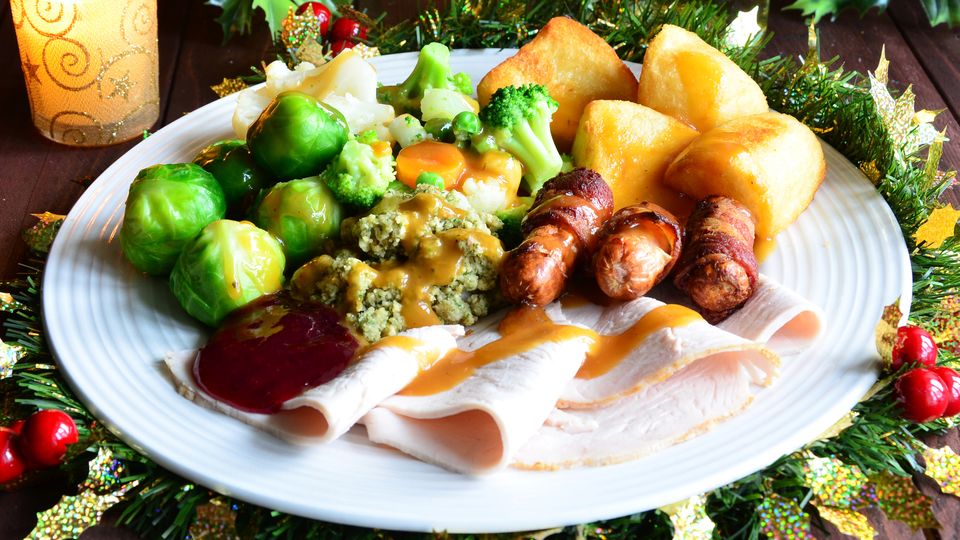What Is the Carbon Footprint of Your Christmas Dinner?
From carrots to pigs-in-blankets, this article breaks down the carbon cost of Christmas dinner.

Complete the form below to unlock access to ALL audio articles.
Feeling climate-conscious this Christmas? Wondering how much CO2 your sprouts cost? You’re not the only one. Recent polling in the UK found that 53% of adults who celebrate Christmas believe it’s important to do so in an environmentally friendly way.
So, what is the best eco-option for a festive meal? Perhaps unsurprisingly, it’s the veggie alternative, at least according to Sarah Bridle, a professor of Food, Climate and Society at the University of York and author of “Food and Climate Change - Without the Hot Air”.
Speaking to Technology Networks in 2020, Bridle broke down the carbon cost of three varieties of a traditional British Christmas dinner: one with turkey as the “main meat”, one with beef and one with a veggie substitute.

Image credit: Sarah Bridle, 2020*
The carbon cost of a turkey Christmas dinner
Turkey is the most common main meat for a Christmas dinner in the UK. It’s also the main element responsible for the dish’s grams of carbon dioxide equivalent (gCO2e), according to Bridle. Her breakdown is as follows:
Turkey: 1,740
Oven for 3.5 hours: 367
Pigs in blankets: 1,118
Port stuffing: 899
Roast potato: 204
Roast carrots: 133
Sprouts: 118
Glass of wine: 236
Total: 4,814 gCO2e
“You can see the turkey, the pigs in blankets, and the pork stuffing are really causing the majority of the emissions,” Bridle told her Teach Me in 10 audience.
“But what if we switched to having beef instead of turkey? How would that compare?”
The carbon cost of a beef Christmas dinner
“You can see the result here is more than twice as large,” Bridle continued.
Beef: 9,240
Oven for 3.5 hours: 367
Pigs in blankets: 1,118
Port stuffing: 899
Roast potato: 204
Roast carrots: 133
Sprouts: 118
Glass of wine: 236
Total: 12,314 gCO2e
“Alternatively, if you were to switch to some of the vegetarian options, then you could get the number right down by a factor of three lower than the traditional Christmas dinner,” she added.
The carbon cost of a vegetarian Christmas dinner
Nut roast: 350
Oven for 1.5 hours: 175
Two vegetarian sausages: 252
Veggie stuffing: 130
Roast potato: 158
Roast carrots: 87
Sprouts: 72
Glass of wine: 236
Total: 1,460 gCO2e
Why does meat cost more carbon?
Our food and the way it’s made are key contributors to climate change. Emissions from worldwide agriculture and livestock activity reached 9.3 billion tons of carbon dioxide equivalent (Gt CO2eq) in 2018 and are on track to keep rising.
“About a quarter of all climate change is due to the food that we eat,” Bridle said. “That includes growing the food, fertilizer, animals, clearing land for agriculture, as well as processing, transport, packaging and getting that food to us.”
“If we were to stop burning fossil fuels, then most of climate change would be caused by food.”
And some foods cost more carbon than others, namely meat.
“Livestock products contribute about 60% of emissions in the food system,” Eva Wollenberg, a research professor of climate change and food systems at the University of Vermont, recently told Technology Networks.
Why is rearing livestock such a carbon-emitting exercise? There are a few reasons. Cattle (which are reared for beef and dairy products) are well-known belchers, contributing to around a third of all “human-caused” methane emissions. These large ruminants also require a lot of grassland to chew through – grassland that often comes at the expense of more biodiverse woodland and forest.
Turkeys may require less land, but they still need a lot of feed, which is mostly derived from corn, wheat and soybean. These crops, combined, take up a lot of land that otherwise could be left to nature.
“Land use is the next major emitter and agriculture is the largest driver of emissions in the land use sector,” Wollenberg added.
This is why many climate change campaigners argue that more people should eat less meat and animal products in order to free up more land for carbon-sequestering woodland and wetland.
Meaty Christmas
The question is: is Christmas really the right time for a dietary switch? Maybe not. Because, according to a recent survey, most dieting Brits – 65% of pescatarians, 58% of vegetarians and 57% of vegans – would give in to temptations over the festive period and eat meat.
So, if you’re looking to make your diet more eco-friendly, perhaps you’re better off waiting a few more days to start long-lasting resolutions in the new year.
*Technology Networks reached out to Professor Bridle, querying the difference between the gCO2e figures for carrots and sprouts in the respective meat and vegetarian meals. A representative responded and surmised that the vegetables were cooked in vegetable oil rather than butter.




